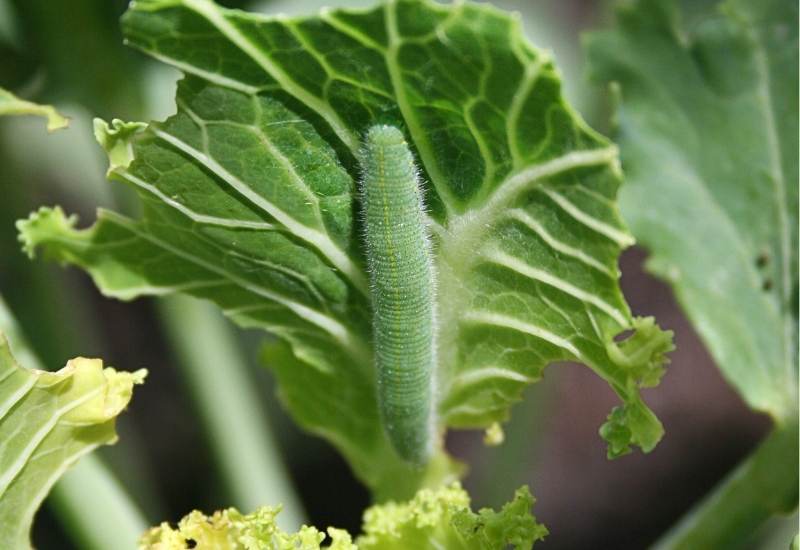
Cabbage worms commonly attack cabbage, kale, broccoli, cauliflower, and other vegetable plants in the cabbage family. Some people refer to these pests as “imported cabbage worms,” and the adults are called cabbage whites or small whites.
At one time, these pests were native to Europe and Asia, but they became common throughout the United States over time.
The name cabbage worms is a generic term given to several species of small, green caterpillars.
All are attracted to the cabbage and mustard plant family, known as the brassica family. However, that doesn’t mean they won’t infest other plants, including flowers.
Cabbage worms are one of the most common garden pests; nearly every gardener will struggle with them at some point.
They camouflage against the leaves and stems, sneaking throughout your garden, causing severe destruction in a short period. These pests chew through entire leaves in a day or two.
With that being said, keep in mind that a few cabbage worms won’t be the end of the world. Try not to panic if you spot a few. Use the methods listed below to get rid of cabbage worms.
What Are Cabbage Worms And Cabbage Moths?
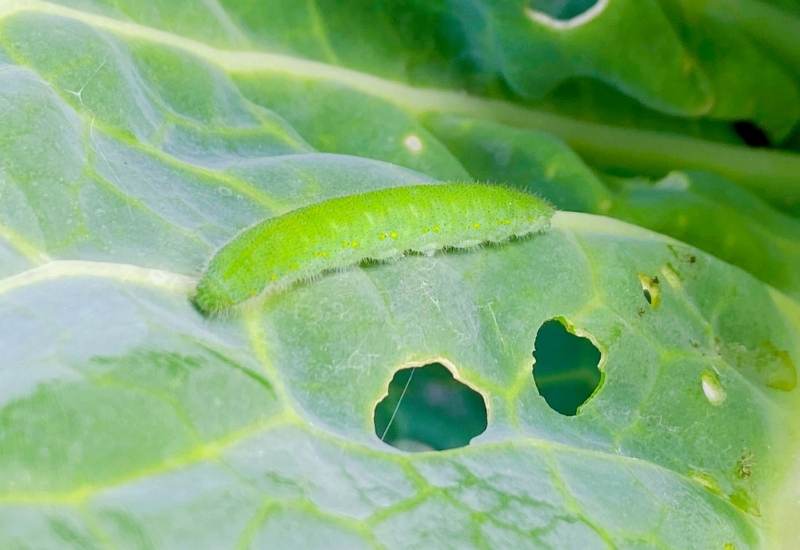
Cabbage worms look like small, velvety-green larvae with a few faint, yellow stripes running the length of their body. They have tiny legs across the underside of their bodies that allow them to move across leaves and plants with ease. Their bodies have multiple segments.
It’s easy to confuse cabbage worms with cabbage loopers, which are yellow-green caterpillars. One of the main differences is that cabbage loopers raise and lower their bodies as they move because they lack middle legs; cabbage worms have middle legs. Cabbage loopers also don’t have any stripes on their bodies.
As cabbage worms age, they become white cabbage butterflies. Chances are you’ve seen these white butterflies with a few black markings fluttering around your garden, but you had no idea that they were working against you. While cabbage white butterflies are pretty, they lay eggs on the undersides of the leaves.
Male cabbage whites have one round black spot on their wings, and females have two black dots. That makes it easy to identify their sex.
Cabbage white butterflies and cabbage worms appear in gardens starting in the early and lasting until late fall. In one season, several generations take place, so staying on top of the infestation is essential.
The Life Cycle Of A Cabbage Worm
The moth or butterfly stage isn’t directly damaging to plants; they leave the destructive job to the larvae or worms. When we think of a cabbage worm’s life cycle, we start with an adult cabbage butterfly or moth.
These little white butterflies dance around the garden, laying eggs on their favorite plants.
They landed on the leaves’ underside, laid an egg, and took off to find another place. An average adult female cabbage moth lays around 200 eggs, and each egg only takes about seven days to hatch, depending on temperature.
Cabbage butterfly eggs look like tiny, white, or yellow oblong dots. Nearly all are attached to the underside of the leaves.
All cabbage worm eggs are solo and sporadic. If you find these eggs, squish them immediately. If you find a cluster of oblong, yellow eggs, leave them in place; those are ladybug eggs.
As the larvae hatch from their eggs, they immediately begin to feed on the surrounding plant matter, creating tiny holes in the leaves.
Gradually, those holes become large. The larvae completely demolish entire leaves and plants as the population grows.
These small caterpillars continue to eat and grow, satisfying their voracious appetites all day long.
This lasts for several weeks until they’re old enough to form a chrysalis and transform into a white butterfly. Then, the process begins again as the adults lay eggs, creating more larvae.
Where Do Cabbage Worms Come From?
Years ago, gardeners in the United States didn’t worry about cabbage worms; they lived exclusively in Europe.
In the 1870s, these pests arrived in Massachusetts and quickly spread throughout the United States. Now, we all have to worry about these insects.
When you see a cabbage worm in your garden, you might wonder where do cabbage worms come from, and the answer is that cabbage worms came from a cabbage moth or butterfly. At some point, a cabbage moth flew into your garden and laid a few eggs on the plants, primarily on the underside of the leaves. Then, the butterfly flew off, more than likely to lay more eggs elsewhere.
It takes less than 30 days for an egg to hatch, eat its way through a plant, and turn into a butterfly.
Then, it’s ready to start the process itself. As you can imagine, once several eggs are laid in your garden, the destruction begins quickly.
How To Identify Cabbage Worms?
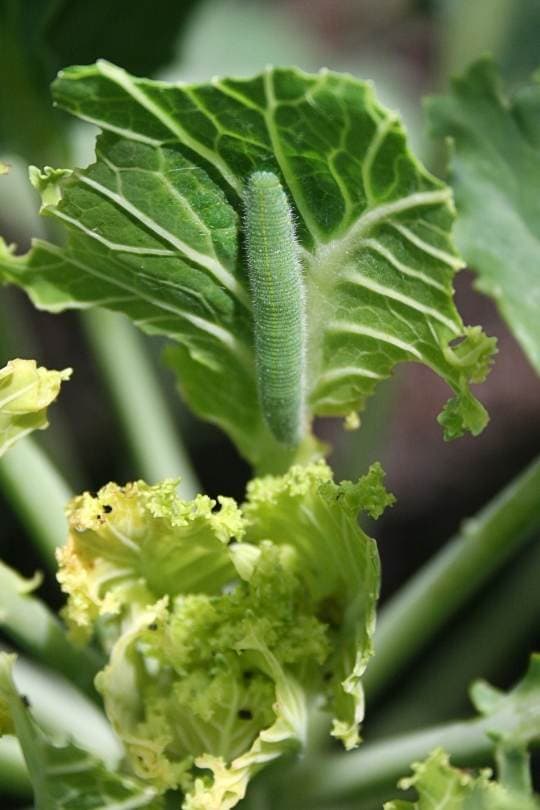
There are several ways to identify cabbage worms. You can either look for the cabbage worms on the plants, look for white cabbage butterflies that indicate their presence, or look for damage caused by cabbage worms.
Heavy infestations are easy to identify. When cabbage worms get to work, they quickly skeletonize entire plants within days. If your cabbage leaves are full of holes with only the large vein in the middle leftover, chances are you have an infestation.
Here’s what to look for to identify cabbage worms in your garden.
Cabbage Worm Damage To Plants
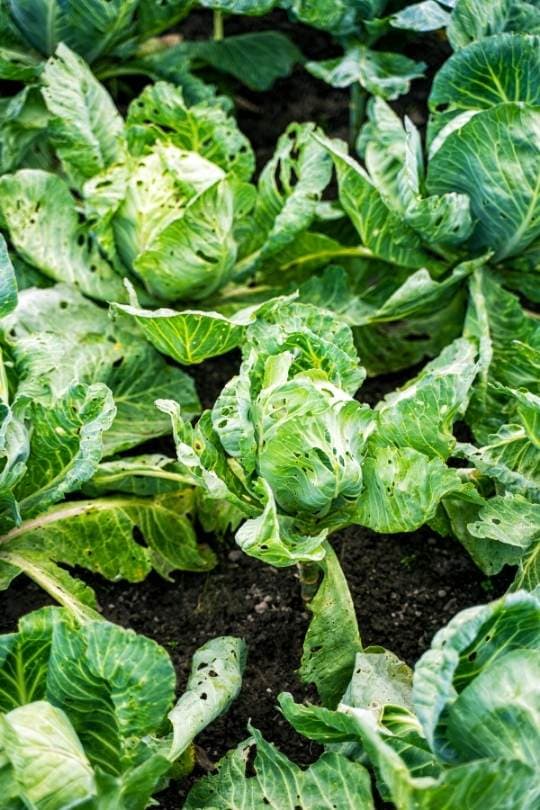
Cabbage worms cause a lot of damage to your plants, eating away at the base of your cabbage, cauliflower, or broccoli plants. Sometimes, they snack on the heads of the plants, blending into the foliage.
Over time, if left alone, cabbage worms continue to feed on the plants’ foliage until only the stems and large veins remain.
Cabbage worms have voracious appetites, feeding constantly. They’re capable of devouring entire crops while their fecal matter stains and contaminating the vegetables leftover.
Damage to plants isn’t only cosmetic. Tender seedlings can be entirely demolished, and mature plants’ defoliation often leads to the entire plant’s death. Without foliage, the process of photosynthesis is severely hindered.
Plants And Vegetables Most Susceptible To Cabbage Worms
As suggested by their name, cabbage worms primarily affect plants in the cabbage family called brassicas. They also like the mustard plant family.
Any plant that belongs to the Brassicaceae family is vulnerable to these pests. Lettuce is often a target as well, despite belonging to a different family. Cabbage worms also feed on nasturtiums or sweet alyssum.
How To Get Rid Of Cabbage Worms In Your Garden
Once you realize that you have a cabbage worm problem, your first thoughts will be able how to get rid of cabbage worms.
Getting rid of these pests is hard. The most effective method is to handpick them off of the plants, but it’s also the most time-consuming option.
Let’s look at all of the ways to eliminate cabbage worms from the garden.
1: Manually Remove The Cabbage Worms By Hands
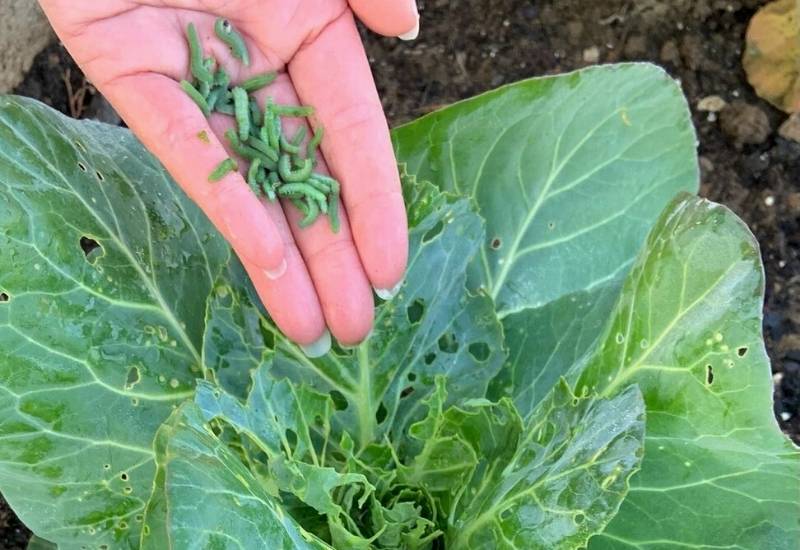
The first step any gardener should try is to remove the worms and eggs from the plant manually. The eggs are tiny and easy to miss; you need to look closely at each leaf’s underside to find them. A thorough examination of all of your cabbage family plants can yield hundreds of eggs, and each one you remove is one less cabbage worm that can damage your plants.
Make sure to look for cabbage moth eggs as well. These are little oblong white to yellow dots that sit solo on the underside of the leaves.
Be sure to put them in a bucket of hot, soapy water to kill them, or manually squish them between your fingers. While a bit gross, manually picking these pests is the easiest and most effective way to stop them quickly if you are only growing a small handful of plants.
For this to be effective, inspect your plants frequently, ideally once or twice per week. Keep in mind that most cabbage worms are found on the underside of leaves or tucked in the new growth at the plant’s center.
2: Catch The Adult Butterflies
Catching adult cabbage white butterflies is another useful way to get rid of cabbage worms. Removing the adults from your garden stops them from laying eggs on the leaves’ undersides, furthering the population.
The easiest and cheapest way to catch adult cabbage white butterflies is to hang a few yellow sticky traps. You can find these traps at most stores; a box costs less than $3 and contains several sticky traps.
The only downside to this method is that you might catch beneficial insects as well. Don’t leave them out too long to avoid damaging the beneficial insect population in your garden.
3: Spray With BT (Bacillus Thuringiensis) To Kill Cabbage Worms
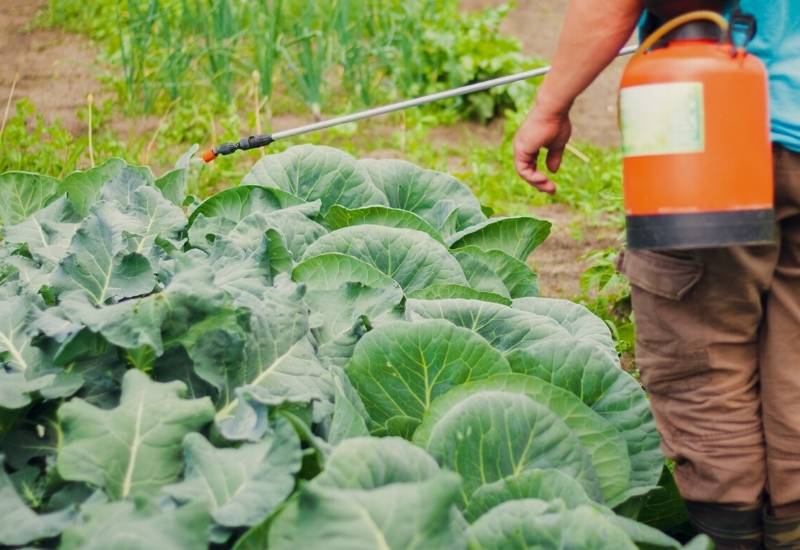
BT stands for Bacillus thuringiensis var. kurstaki; try saying that five times fast. Instead, everyone refers to it as BT, and it’s a naturally-occurring, soil-dwelling bacteria that is a common, active ingredient used in organic biological pesticides.
The one thing to know about BT is that it kills caterpillars, but it’s only toxic against butterflies or moths’ larvae. Using BT stops the caterpillars from eating, so it’s a considered to be the best organic pesticide to eliminate cabbage worms. Spraying with Bt on your garden every one to two weeks helps to control cabbage family pests.
Bt spray is available in a pre-mixed formula, as well as a concentrate that needs to be diluted before being applied to plants.
Buying a concentrate is the most cost-effective option. When applied to a vegetable plant, BT is considered safe for human consumption even if sprayed the same day as harvest.
Some gardeners prefer to use Sevin, but understand that this contains potentially damaging chemicals. Sevin is toxic, and organic gardeners should avoid its use as much as possible.
4: Spraying Neem Oil On Plants To Get Rid Of Cabbage Worms
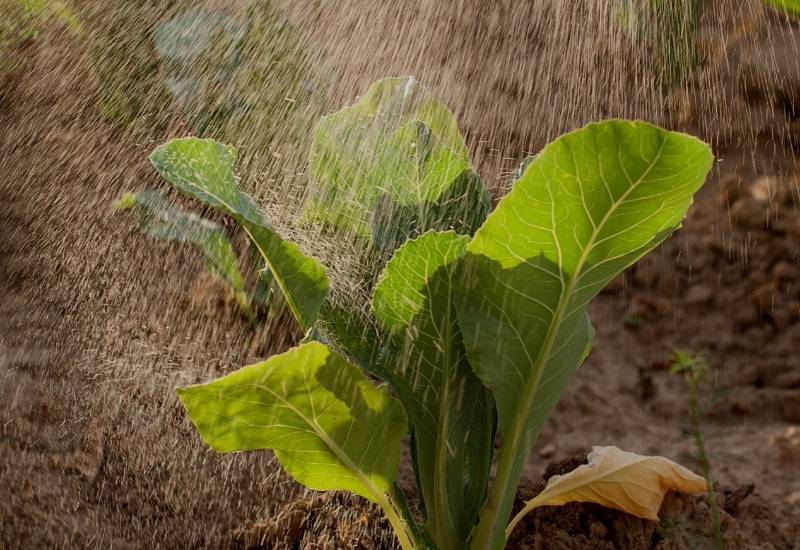
Neem oil is a plant-based pesticide that comes from the neem tree, which is native to India.
Diluted neem oil, bought either pre-diluted or as a concentrate, can be sprayed onto plants as an organic pest control. While it’s most effective on small, soft-bodied insects, such as aphids, thrips, spider mites, and caterpillars, but you can spray nee moil directly on the cabbage worms to kill them off.
When applied directly, the neem oil coats their body and kills them. It also is an effective repellent for cabbage moths, flies, and mosquitoes. Spraying your garden routinely with neem oil makes your garden and plants less attractive to a range of pests.
However, neem oil isn’t as effective at eliminating an infestation than other options.
Despite that, all organic gardeners should have neem oil available. It combats fungal diseases, such as powdery mildew, and doesn’t hurt beneficial insects when used correctly.
5: Make A DIY Cabbage Worm Repellant Spray
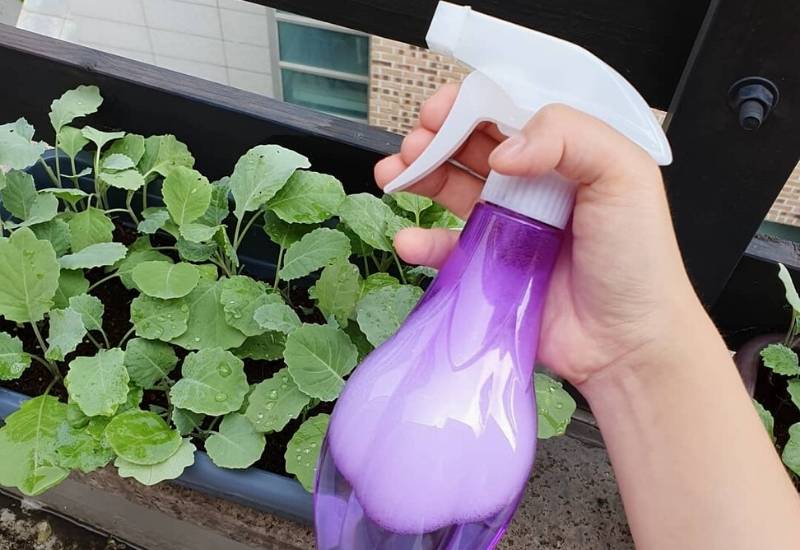
If you want to try making a DIY repellant spray, here is one to try. This is what you need.
How to Make a Homemade Cabbage Worm Spray
1. Put all of the ingredients into a blender and mix in an equal amount of water. Blend until no chunks exist.
2. Pour through a fine mesh strainer, collecting the liquid to be put into a spray bottle. Don’t toss out the solid pieces!
3. Spread the solid materials under the plant, and use the existing liquid in a spray bottle.
4. Add a tablespoon of dish soap to the spray bottle, and spray your plants between waterings. Make sure to cover the leaves thickly with this homemade cabbage worm spray.
5. Apply after each rain because it runs off with water.
6: Sprinkle With Cornmeal
Here is a simple DIY organic method for getting rid of cabbage worms. Dampen the leaves on the plant and sprinkle them with cornmeal. Eating cornmeal causes these little caterpillars to swell and die.
7: Try Rye Flour
Ready to try an old trick? Years ago, gardeners sprinkled rye flour over their cabbage family plants in the early mornings. It causes the cabbage worms to dehydrate and die. Talk about simple.
How To Prevent Cabbage Worms
Unfortunately, controlling cabbage worm damage is tricky, so the best course of action is to prevent them from arriving in your garden in the first place. Prevention is always easier than getting rid of pests.
Here are few tips for preventing cabbage worms from eating your plants:
1: Cover With Row Covers
When you plant the seedlings in the spring, immediately cover the plants with a row cover. Doing so protects these delicate seedlings from potential spring frosts and deters adult cabbage white butterflies from laying eggs on the plants.
If the butterflies are unable to lay eggs in your garden, an infestation will never start. No matter if you have individual plants, raised beds, or sections in the ground, you can use the traditional hoop structures often called floating row covers.
There are different types of floating row covers; some stop insects, and others are for frost protection or providing shade.
If you decide to use row covers, make sure to tuck in the corners and sides tightly. Clothespins can help with this.
If the sides aren’t tight, pests can still enter. The great thing about row covers is that they can protect plants from rabbits, birds, cats, deer, squirrels, and more.
2: Release Trichogramma Wasps
Don’t be afraid of the name “wasps,” these are so tiny that they’re incapable of stinging humans.
Instead, Trichogramma wasps parasitize the eggs of the cabbage worm. Releasing these into your garden requires proper timing, and they must be ordered online. It’s almost impossible to find a garden nursery center that carries them. The company that you order these from should be able to help you understand proper timing.
Parasitic wasps large their eggs inside or on top of other arthropods, including caterpillars. That makes these wasps a great tool against cabbage worms because once the wasp larvae feed on the host caterpillar, the cabbage worms die.
3: Try Companion Planting To Fight The Cabbage Worms
Every gardener should use companion planting. It’s a simple method of planting different crops and flowers near each other that deter the common pests that bother those plants.
Growing various plants together creates biodiversity, and polyculture, which is the mixing of more than one type of plant in one space, reduces the risk of widespread damage by pests all attracted to the same crop.
What does that mean for you? It means that you shouldn’t plant an entire garden bed of cabbage and nothing else. Interplanting companion plants is a good idea.
For example, thyme, a common herb, repels cabbage worms. Planting thyme near your vulnerable plants is one simple trick that keeps some of the infestations away.
At the same time, another trick is to plant trap crops near your vulnerable plants. Trap crops attract the pests away from the plants you want to keep. That means you have to sacrifice a few plants, but that’s the price you have to pay for a healthy garden.
An example is mustard plants. Cabbage worms love mustard plants, so planting mustard near your cabbage keeps them away. Once the worms take over the mustard plant, remove it entirely from your garden and destroy all of the pests.
3: Plant Red And Purple Leafed Varieties Of Cabbage
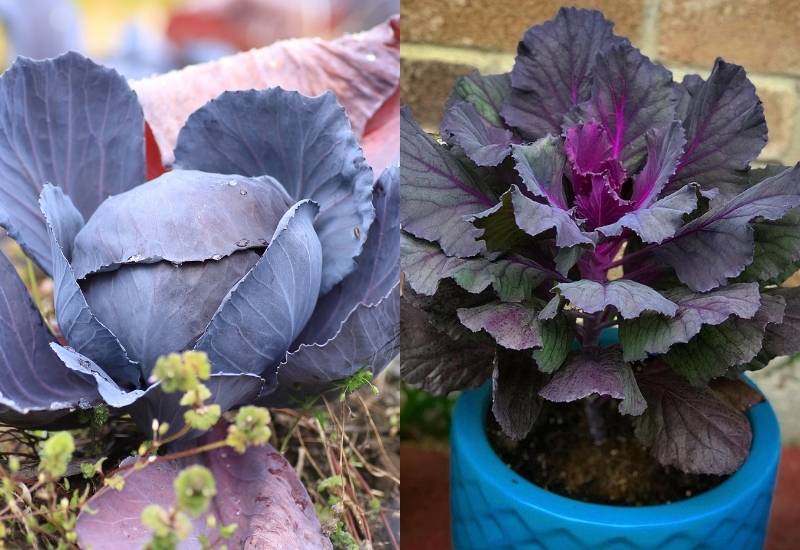
Planting red and purple leaf varieties of cabbage make it harder for the worms to camouflage. It’s hard to spot a green caterpillar on a green leaf, but it’s much easier to spot it on a purple leaf.
The pests understand this, looking for places to camouflage, so they’re less likely to pick those plants.
Another reason pests seem to be less attracted to purple and red-colored vegetables is that they contain anthocyanin, an antioxidant-rich flavonoid that creates red, purple, and blue-pigmented vegetables good for us.
Anthocyanin is mildly toxic to caterpillars, and it might deter larger pests as well.
Frequently Asked Questions About Cabbage Worms
Getting rid of cabbage worms is a difficult task. Here are some of the most common questions gardeners have about eliminating cabbage worms in their garden.
Are Cabbage Worms Harmful To Humans?
Cabbage worms are harmless to humans. No harmful pest hides on cabbages. You don’t need to worry about what happens if you eat a cabbage worm accidentally – you won’t die. It might not be appetizing, but it’s far from harmful.
Will Dish Soap Kill Cabbage Worms?
Dropping cabbage worms in a bucket of soapy water kills cabbage worms, but spraying plants with a soapy water mixture won’t. Spraying your plants with dish soap repels these worms because it’s less appetizing to much on leaves covered with soap.
Will Baking Soda Kill Cabbage Worms?
Baking soda on its own won’t kill cabbage worms, but if you dust your plants with equal parts baking soda and flour, it’s an effective method to kill cabbage worms.
Mix one cup baking soda and one cup flour, liberally spread the mixture over your infected plants. Repeat after watering or rain because the water washes it off.
Does Boiling Kill Cabbage Worms?
A myth surrounds cabbage worms that says not even boiling kills them, making it scary for gardeners who are worried about eating their cabbage heads.
Rest assured, boiling kills cabbage worms. If you plan to blanch and freeze cabbage heads, cabbage worms will die. If you boil for any other reason, the worms will die. No pests survive boiling.
Will Vinegar Kill Cabbage Worms?
Vinegar, on its own, won’t kill cabbage worms, but it’s useful to repel them. When used in conjunction with other ingredients, vinegar is an effective treatment for these pests.
Try mixing ¼ cup white vinegar, ¾ cup water, and one teaspoon of dish soap in a spray bottle. Liberally spray your plants to repel the cabbage worms.
Final Thoughts
Dealing with cabbage worms is frustrating. A small infestation quickly turns into severe damage when left unchecked. Use these simple methods to prevent cabbage worms, and check plants common to remove any eggs that might appear manually.
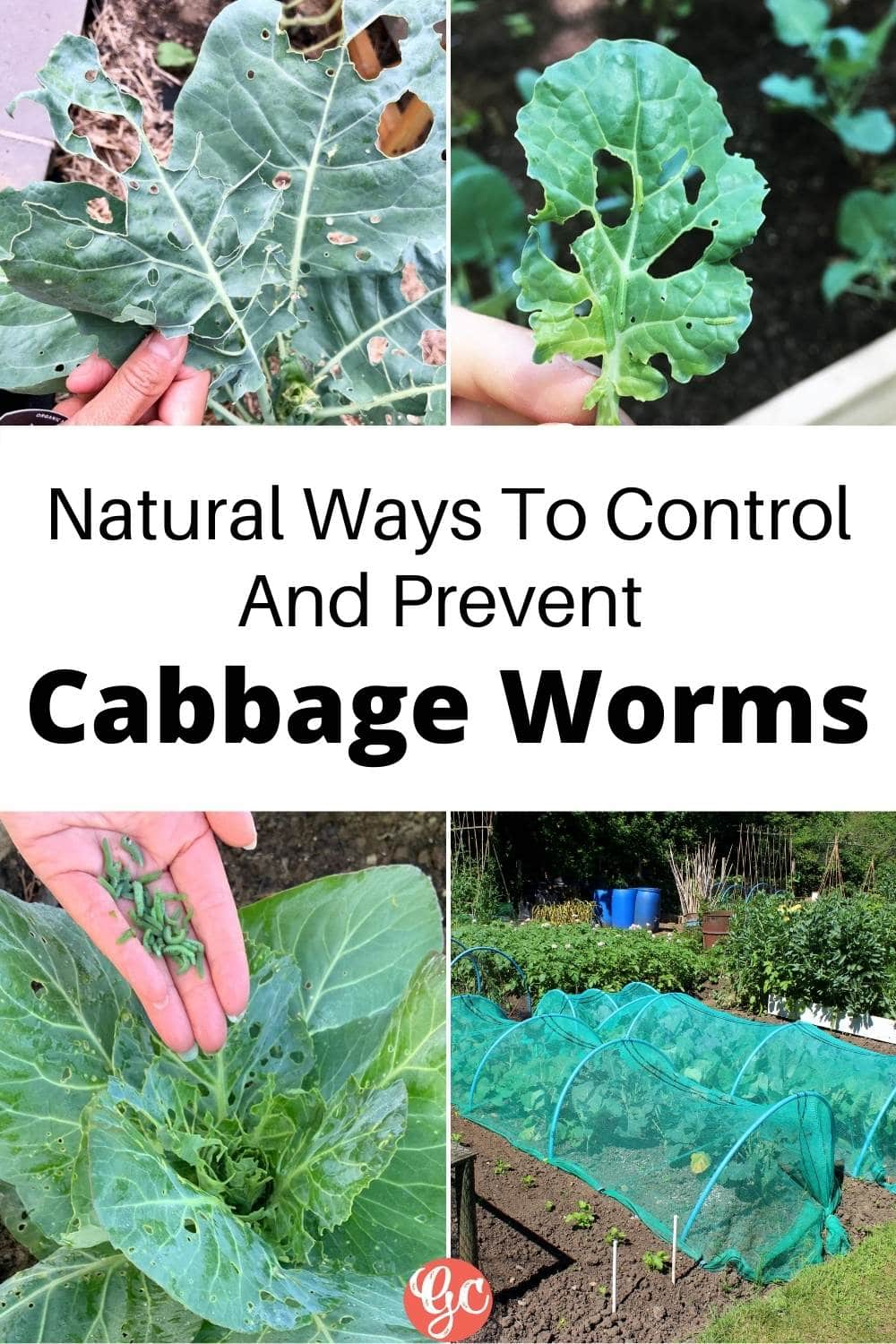

Written By
Amber Noyes
Amber Noyes was born and raised in a suburban California town, San Mateo. She holds a master’s degree in horticulture from the University of California as well as a BS in Biology from the University of San Francisco. With experience working on an organic farm, water conservation research, farmers’ markets, and plant nursery, she understands what makes plants thrive and how we can better understand the connection between microclimate and plant health. When she’s not on the land, Amber loves informing people of new ideas/things related to gardening, especially organic gardening, houseplants, and growing plants in a small space.
